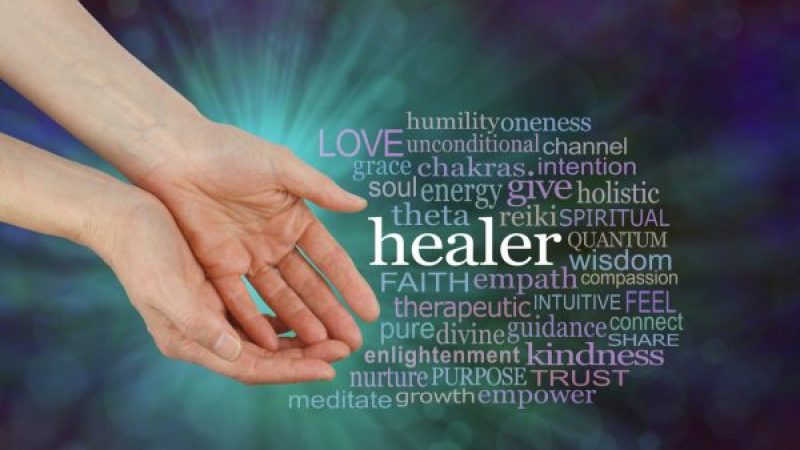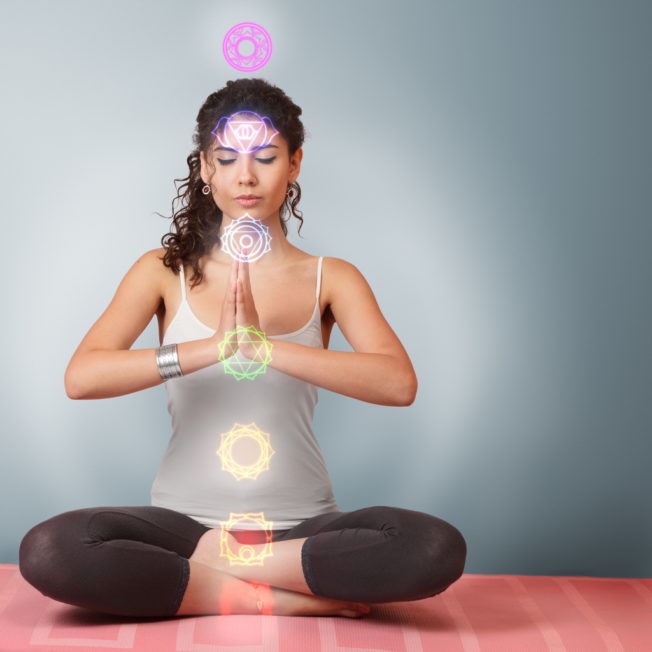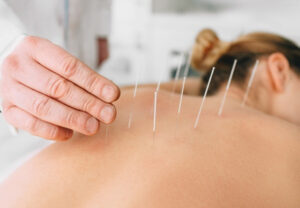Does Energy Healing Really Work?
Does Energy Healing Really Work?
Does Energy Healing Really Work?

Does Energy Healing Really Work?
By Jancee Dunn Updated on July 5, 2022 Medically reviewed by Arno Kroner, DAOM, LAc
The field of energy healing has been around for centuries in Eastern cultures and is becoming more mainstream on this side of the globe too. There’s also a lot of confusion around it. What is it, exactly? Are there credible studies on it? And isn’t it just a little bit…woo-woo?
Let’s start with its definition. According to the National Center for Complementary and Integrative Health (NCCIH), the government’s lead agency for research on non-conventional medicine, energy medicine (or biofield therapies) is the act of channeling and manipulating the energy that courses through your body in order to heal it. This can reportedly be done with hands-on practices, such as acupuncture and Reiki, as well as sensory-based experiences, like the use of crystals, sound baths, and aromatherapy.
While some of this might sound too “out there” for you, some of it does have some credibility.
The Medical Theory
Energy practitioners believe that your body is instilled with a subtle energy—or animating life force—the flow of which must be balanced for good health. According to Johns Hopkins Medicine, in Traditional Chinese Medicine (TCM), this force is called qi (pronounced “chee”). Johns Hopkins Medicine also states that in Ayurvedic medicine, which originated in India, this energy is represented in the doshas—three energies (vata, pitta, and kapha) that provide every person’s makeup. The basis of energy medicine is removing blocks in your body’s energetic field that can cause poor health.
Energy medicine has been around for thousands of years. But even with its long history, people find it hard to wrap their heads around energy medicine, said licensed acupuncturist, clinical herbalist, and doctor of Chinese medicine Jill Blakeway, author of the book “Energy Medicine: The Science and Mystery of Healing.”
This is not helped by the fact that this field is, as Blakeway said bluntly, “rife with quackery.” Anyone can basically call themselves an energy healer, said Blakeway, a funny, forthcoming Brit who works with MDs and is the opposite of woo-woo. “While practitioners of Traditional Chinese Medicine are licensed and do either a four-year masters or a five-year doctorate, there are no minimum standards for most other types of energy work.”
Yufang Lin, MD, an integrative medicine physician at the Cleveland Clinic who is trained in Reiki and qigong, explains to her patients that energy is the foundation for everything we do with our bodies. “The idea is that we have this bank of energy, and we have to restore it or replace it,” said Dr. Lin. “In Chinese medicine and Ayurveda, if the energy isn’t flowing well, we get sick.”
We’ve all picked up on other people’s energy when we say that a person has good vibes or negative energy. “You can absolutely feel it,” said Judith Orloff, MD, an energy healer from Santa Monica, California, and a psychiatrist on the UCLA clinical faculty. Most of us have experienced what Dr. Orloff called an energy hangover: “That’s when the energy of an interaction or an event lingers the next day when you wake up,” said Dr. Orloff, “and it literally feels like a hangover.”
Gathering Evidence
These days, it seems like everyone in the wellness world is heading into the mystic. But it’s not just trendy celebrity spirit warriors who have energy healers on speed dial—some of the country’s best hospitals are hiring them too. The Memorial Sloan Kettering Cancer Center offers acupuncture to its patients; Duke University Health System has acupuncture, yoga therapy, and massage therapy on their menu of services; and Mayo Clinic’s campus in Rochester, Minnesota, offers Reiki. UCSF Osher Center for Integrative Health offers a line-up of classes and medical staff who specialize in energy healing areas, including Ayurveda, TCM, and acupuncture. And New York-Presbyterian provides aromatherapy for stress reduction along with various mind-body techniques like meditation and breathing exercises.
Some forms of energy medicine are backed by research. Acupuncture—skillfully placing very thin needles in specific spots on the body—is supported by solid studies on a number of health issues. For example, a 2022 review of the literature published in the journal Medical Acupuncture suggests that acupuncture is a safe adjunct to other treatments to help reduce pain and disability in people with low back pain.
And despite acupuncture involving needles, it tends to elicit a relaxation response. Blakeway’s patients sometimes ask her, “What do you put in the needles?” They become so calm during her sessions, that they assume she’s coated her needles with a sedative.
Reiki—a technique that involves a practitioner placing their hands either just above your body or lightly touching it—has also been shown to be an effective pain-reducer, according to a 2018 review of the literature published in the journal Complementary Therapies in Clinical Practice.
And a 2017 review published in the Journal of Evidence-Based Complementary & Alternative Medicine showed that when compared to a placebo, Reiki was more effective at reducing anxiety and depression and improving self-esteem and overall quality of life.
According to 2019 research published in The Journal of Alternative and Complementary Medicine, energy healing, like Reiki, may also help people reduce their stress and increase feelings of relaxation and wellbeing.
This is important because according to the Centers for Disease Control and Prevention (CDC), stress is a culprit in many conditions, including nightmares and sleeping problems, worsening physical and mental conditions, body pain, skin rashes, stomach problems, and increased use of alcohol and other drugs.
Yet, for many energy therapies, scientific evidence is still lagging. One reason is that large, carefully controlled medical studies are costly—and often funded by big companies that develop drugs. “With something like Reiki…there’s nothing to sell,” said Dr. Lin.
But as demand grows, more studies are being commissioned as more leading organizations are jumping on board. For example, the NCCIH states that one of its top research priorities is “nonpharmacologic management of pain.”

The Power of Belief
Of course, it’s entirely possible that some of the healing benefits patients report arise from the so-called placebo effect—in which the brain convinces the body that a particular treatment will work, and then it actually does.
According to the NCCIH, “the placebo effect is a beneficial health outcome resulting from a person’s anticipation that an intervention will help.” For example, the placebo effect may result in less pain or fatigue.
How the effect works exactly is still a mystery, but according to 2020 research published in The Lancet, it may involve a burst of feel-good neurotransmitters like dopamine and endorphins. And a 2021 study in the journal Nature suggests that many areas of the brain are involved in placebo-mediated pain control.
Even Blakeway admits that energy healing likely contains an element of placebo—so if you believe it will work, it’s more likely to work. But as she points out, if it’s functioning as part of the healing process, why fear it?
Dr. Lin said that when she was in med school, she was taught a simple formula: Identify a disease by listening to the symptoms, then treat it with drugs. Now that she has moved into energy healing, the first question she tries to answer is: What is triggering the illness? “Then we try and remove that trigger,” said Dr. Lin.
Energy healing requires you to listen carefully to what your body is telling you, added Dr. Orloff. “That’s really the beauty of it. It’s about tapping into your own intuition and ability to heal.”
Therapies With Some Cred
All kinds of approaches get thrown into the energy bucket—from color therapy to intuitive healing—but these five have gained the most traction.

Acupuncture
The research is probably most robust around acupuncture, which has been used for more than two millennia in TCM. The practice involves inserting thin needles at specific points to improve the overall movement of qi through the body. It’s believed that there are energy networks—called meridians—through which qi travels. Most meridians correspond to a major organ—like the lungs or the stomach—and most acupuncture points lie on those meridians.
Many Western doctors now believe that stimulation from the needles may boost endorphins, aka your body’s natural painkillers. In a 2022 review published in the American Journal of Translational Research, study authors state that evidence suggests acupuncture alleviates acute pain in conditions like labor pain, post-op pain, tension headaches and migraines, and even period cramps. These same researchers found that acupuncture is also helpful for chronic pain associated with the low back, shoulders, and neck, as well as osteoarthritis in the knee.
Acupuncture is a holistic approach, said Debbie Lamadrid, an acupuncturist at the Mayo Clinic in Phoenix. “The goal in Chinese medicine is to address the entire person, not just their symptoms.”
Qigong
According to the NCCIH, qigong is a part of TCM and has been around for thousands of years. A 2020 review of the literature published in the journal Complementary Therapies in Medicine states that qigong is a sort of umbrella term for a variety of TCM-related energy exercises. For example, tai chi is a form of qigong.
Both tai chi and dynamic qigong involve slow, meditative movements, focused attention and controlled breathing. Passive qigong involves meditative breathing and mind exercises that can be done in any position and requires little to no movement.
Research is slowly mounting to support the benefits of qigong. That same 2020 literature review in Complementary Therapies in Medicine looked at 886 studies that involved qigong and various health conditions and found that 96.5% of them reported positive results with qigong. The health conditions included diabetes, fibromyalgia, depression, cancer, anxiety, arthritis, blood pressure…and the list goes on.
Reflexology
According to the National Institutes of Health‘s (NIH) National Cancer Institute, the Chinese meridian theory states that there are channels—or meridians—that form a network inside your body and that points on your feet, hands, and ears are connected with other parts of your body. For example, TCM believes that certain toes reflect your head and that specific points on the palms of your hands are linked to your kidneys.
The belief is that when points within those energy centers are stimulated, they can improve energy circulation and rejuvenate corresponding areas elsewhere in the body. So reflexology is simply massaging or pressing on certain points on your hands, feet, or ears that correspond to the areas in which you’re having trouble.
Research on reflexology is sparse, but a 2020 study published in the journal Surgical Laparoscopy, Endoscopy & Percutaneous Techniques found that both foot and hand massage decreased people’s post-op pain and anxiety levels. And in a 2021 review of the literature published in the Journal of Advanced Nursing, researchers found that foot reflexology seems to significantly improve sleep.
Reiki
In the practice of Reiki, practitioners put their hands on or right above your body (which in most cases is fully clothed) in order to direct energy. The name is formed from the Japanese words Rei (spirit) and Ki (vital energy).
Vickie Bodner, a licensed massage therapist and Reiki master in Cleveland, Ohio, said that patients often come to her for physical and emotional pain, such as fibromyalgia, immune system issues, or depression.
As mentioned earlier, it’s also good for stress relief. And while the NCCIH states that research on Reiki is mixed, “Patients find it comforting, calming, and soothing,” said Bodner.
While research is mixed on certain energy healing therapies, teaching your nervous system to relax and learning to manage your stress is something everyone should master—whether it’s with or without one of these therapies.
